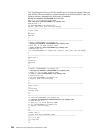
>>>----------------------------------------------------------------------
>>Type/Subtype: image/GIF
>>>Description: (BRICK.BMP)
>>>
How the File Name is Derived
During the POP (MIME)-note-to-OfficeVision-note conversion process, multimedia
subparts are converted to OfficeVision/400 document PC files. These OfficeVision
document PC files are binary representations of the particular multimedia subpart
that they represent. When these OfficeVision document PC files are generated, a
file name is derived to store in the Document Interchange Architecture (DIA) portion
of the OfficeVision document. When the document is sent to a POP mail user, the
file name is used for the content description and also as the
name=
parameter
content for the content type. This allows MIME-compliant clients to use the file
name to determine what type of object the attachment is and which handler to run
against it.
A MIME-compliant POP client can set the file name in the following ways:
v Include the file name as the
filename=
parameter of the Content-Disposition
header.
v Specify the file name on the
name=
parameter of the Content-Type header.
v Place the filename.ext in the Content-Description header.
The POP server tries to determine the file name by successively looking in these
places. When a header is found, the MIME parser attempts to parse the file name.
If a blank string is returned, the internal file name that is used in the conversion
process is used. If a file name is parsed, then the filename portion of the
filename.ext is limited to 8 characters and the ext is limited to 3 characters. This
allows all file allocation table (FAT) file systems to process these files.
MIME Content Types
Table 26 on page 306 shows how each type and subtype of the primary header are
handled. These are defined in the content-type header. These tables are for
reference only, and show which MIME Content-Type headers the POP server
supports.
Table 27 on page 306 shows how each type and subtype of the individual part
headers are handled. These are defined in the Content-type header.
What Happens When You Send OfficeVision Mail to POP Clients
When you send an OfficeVision note to a POP user, the POP server sends the
entire contents of the OfficeVision note and includes any headers that OfficeVision
may have inserted. The character set that is used for the
charset=
parameter is
determined by the value of the MIMECCSID When_to_Use parameter element of
the Change POP Attributes (CHGPOPA) command. If this parameter is set to
*ALWAYS, the EBCDIC Coded Character Set Identifier (CCSID) is forced to the
ASCII CCSID that is defined in the CHGPOPA menu. If the parameter is set to
*BESTFIT, the appropriate ASCII CCSID that produces the best fit based on the
EBCDIC CCSID is used. The ASCII CCSID value is then used to look up the
equivalent ISO-8859-x character set for the
charset
parameter.
Chapter 9. Post Office Protocol (POP) Mail Server 305


















